Click on images to enlarge
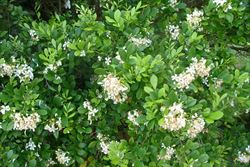
habit in flower (Photo: Sheldon Navie)
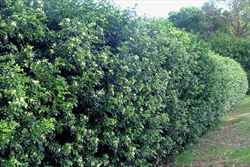
habit cultivated as a hedge (Photo: Sheldon Navie)
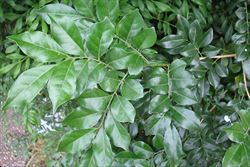
once-compound glossy leaves (Photo: Sheldon Navie)

flowers (Photo: Sheldon Navie)
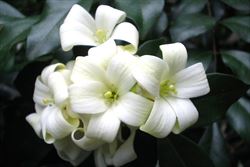
close-up of flowers showing petals that are bent backwards at their tips (Photo: Sheldon Navie)
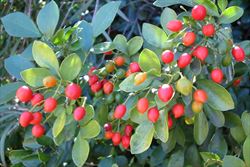
immature and mature fruit (Photo: Sheldon Navie)

close-up of mature fruit (Photo: Sheldon Navie)
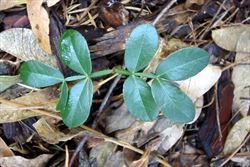
seedling (Photo: Sheldon Navie)
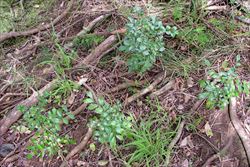
young plants growing under a tree in a bushland area (Photo: Sheldon Navie)
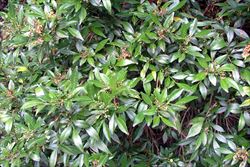
the native form of mock orange, Murraya paniculata, with smaller leaflets (Photo: Sheldon Navie)
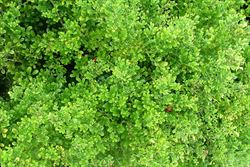
dwarf mock orange, Murraya paniculata 'Min-a-min', another ornamental cultivar of this species (Photo: Sheldon Navie)
Scientific Name
Murraya paniculata (L.) Jack.
Synonyms
Camunium exoticum (L.) KuntzeChalcas paniculata L.Chalcas paniculata L. var. zollingeri TanakaMurraea exotica L.Murraya exotica L.Murraya exotica L. var. exoticaMurraya exotica L. var. ovatifoliolata Engl.Murraya ovatifoliolata (Engl.) DominMurraya paniculata (L.) Jack 'Exotica'Murraya paniculata (L.) Jack var. exotica (L.) C.C. HuangMurraya paniculata (L.) Jack var. ovatifoliolata (Engl.) SwingleMurraya paniculata (L.) Jack var. paniculataMurraya paniculata (L.) Jack var. zollingeri (Tanaka) Tanaka
Family
Rutaceae
Common Names
China-box, Chinese box, common jasmine-orange, cosmetic bark tree, Hawaiian mock orange, Hawaiian mock-orange, honey bush, jasmine orange, jasmine-orange, jessamine, mock lime, mock orange, mock-orange, murraya, orange jasmine, orange jessamine, orange-jasmine, satin wood, satin-wood, satinwood
Origin
Mock orange (Murraya paniculata) is native to southern China, Taiwan, the Indian sub-continent (i.e. India, Nepal, north-eastern Pakistan and Sri Lanka), south-eastern Asia (i.e. Cambodia, Laos, Myanmar, Thailand, Vietnam, Indonesia, Malaysia and the Philippines) and northern Australia (i.e. the northern parts of the Northern Territory, far northern Queensland and northern Western Australia).
The widely naturalised cultivar Murraya paniculata 'Exotica', which is very common in cultivation in Australia, is not native to this country.
Cultivation
Mock orange (Murraya paniculata 'Exotica') is widely cultivated as a garden and hedging plant, particularly in the warmer parts of Australia. Other forms of this species are also becoming common in cultivation, including dwarf mock orange (Murraya paniculata 'Min-a-min').
Naturalised Distribution
Mock orange (Murraya paniculata 'Exotica') is widely naturalised in the coastal districts of eastern Queensland and northern New South Wales.
Mock orange (Murraya paniculata) is also naturalised overseas on La Réunion, in south-eastern USA (i.e. Florida), Central America (e.g. Belize and Panama) and Hawaii.
Habitat
A weed of closed forests, open woodlands, watercourses (i.e. riparian areas), native bushland, forest margins, pastures, disturbed sites, waste areas, gardens and roadsides in the wetter tropical and sub-tropical regions of Australia.
Habit
A bushy shrub or small tree usually growing 2-4 m tall, but occasionally reaching up to 7 m in height.
Distinguishing Features
- a bushy shrub or small tree usually growing 2-4 m tall.
- its alternately arranged leaves are once-compound (6-11.5 cm long) with 3-9 glossy leaflets.
- its fragrant flowers are borne in clusters at the tips of the branches or in the upper leaf forks.
- these white flowers (10-18 mm long) have five petals that are curved backwards.
- its small egg-shaped or oval fruit (about 10 mm long) turn from green to orange or bright red in colour as they mature.
Stems and Leaves
Its younger stems are green and hairless (i.e. glabrous) or covered in tiny hairs (i.e. minutely pubescent). Older stems become woody and brown or grey in colour. They can reach up to 13 cm across and may eventually becoming fissured and rough.
The leaves are alternately arranged along the stems and borne on stalks (i.e. petioles). These leaves (6-11.5 cm long) are once-compound (i.e. pinnate) with 3-9 leaflets. The glossy leaflets (1.5-7 cm long and 1.2-3 cm wide) are narrowly oval (i.e. narrow-elliptic) to somewhat egg-shaped in outline (i.e. ovate or obovate). They have entire margins, wedge-shaped (i.e. cuneate) bases, and pointed tips (i.e. acuminate apices).
Flowers and Fruit
The fragrant flowers are borne in clusters, containing up to eight flowers, at the tips of the branches or in the upper leaf forks (i.e. terminal or upper axillary cymes). Each flower has five green sepals and five white petals (10-18 mm long) that are curved backwards (i.e. recurved). They also have ten stamens and an ovary topped with a style and a globular (i.e. capitate) stigma. Flowering occurs irregularly throughout the year, often in response to rain, but is most common from late winter through to late spring.
The fruit is an egg-shaped (i.e. ovoid) to oval (i.e. ellipsoid) berry about 10 mm long. They turn from green to orange or bright red in colour as they mature and contain one or two dull, yellowish-grey or greenish, teardrop-shaped seeds.
Reproduction and Dispersal
This species reproduces by seed. These seeds are most commonly spread by birds and other animals that eat the brightly-coloured fruit. They may also be dispersed in dumped garden waste.
Environmental Impact
Mock orange (Murraya paniculata 'Exotica') is regarded as an environmental weed in New South Wales and Queensland. This species was first recorded becoming naturalised in Sandgate, in south-eastern Queensland, in 1963. It is invasive and naturalising in south-eastern and central Queensland and also has the potential to become a serious weed in northern Queensland.
Mock orange (Murraya paniculata 'Exotica') is currently ranked among the top 200 most invasive plant species in south-eastern Queensland. It also appears on several local environmental weed lists in this region (e.g. in Hervey Bay City, Maroochy Shire, Caboolture Shire and Redland Shire). In a recent survey of three suburban sub-tropical rainforest patches in Brisbane, it was found that mock orange (Murraya paniculata 'Exotica') had established in low to moderate densities at all study sites. It was also found that this species is capable of growth to maturity beneath an intact rainforest canopy.
In New South Wales, mock orange (Murraya paniculata'Exotica') has been recorded in drier lowland sub-tropical rainforests in coastal districts north from Taree. It also appears on environmental weed lists in this region (i.e. in the New South Wales North Coast region, in Byron Shire and Lismore City). It is also seen as a potential environmental weed in the Sydney region.
Legislation
Not declared or considered noxious by any state government authorities.
Similar Species
Native mock orange (Murraya paniculata) is very similar to the cultivated exotic form of mock orange (i.e. Murraya paniculata 'Exotica'). These plants can usually be distinguished by the following differences:
- mock orange (Murraya paniculata 'Exotica') has relatively large leaflets (3-7 cm long).
- native mock orange (Murraya paniculata) has relatively small leaflets (1.5-4 cm long).

